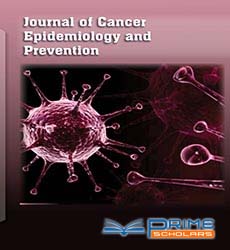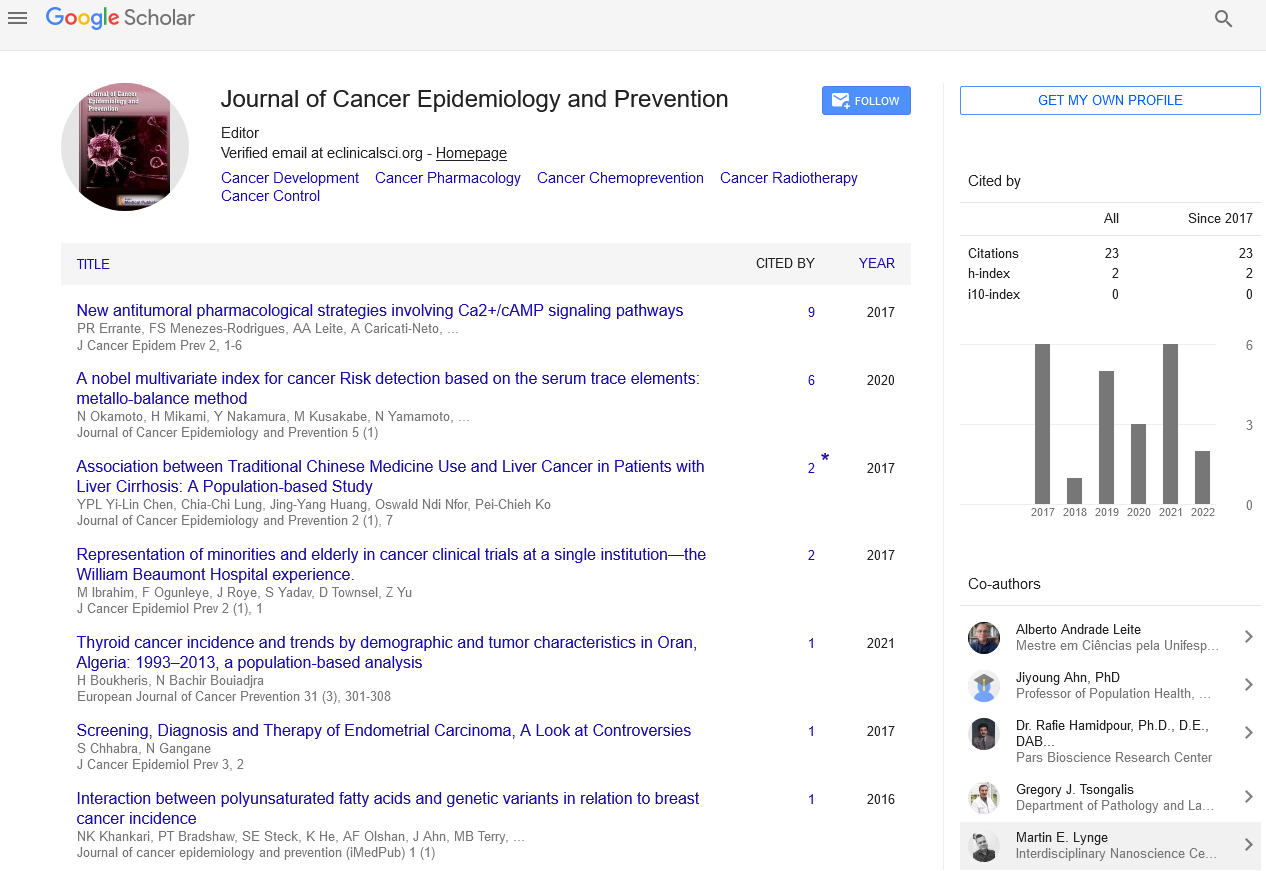Short Communication - (2022) Volume 7, Issue 2
Patients around the World Lack Timely to High-Quality Diagnosis and Treatment
Ando Miyuki*
Department of Cancer Researches, Peking University Hospital, China
*Correspondence:
Ando Miyuki, Department of Cancer Researches, Peking University Hospital,
China,
Email:
Received: 30-Mar-2022, Manuscript No. IPJCEP-22-13256;
Editor assigned: 01-Apr-2022, Pre QC No. IPJCEP-22-13256 (PQ);
Reviewed: 15-Apr-2022, QC No. IPJCEP-22-13256;
Revised: 22-Apr-2022, Manuscript No. IPJCEP-22-13256 (R);
Published:
29-Apr-2022, DOI: 10.36648/ipjcep.7.2.10
Introduction
Cancer is a broad term for a collection of diseases that begin in
practically any organ or tissue of the body and spread to other
organs when aberrant cells grow out of control, cross their
normal boundaries, and invade other regions of the body. The
latter is known as metastasizing, and it is one of the leading
causes of cancer death. Other frequent terms for cancer include
neoplasm and malignant tumour.
Description
Cancer is the second most common cause of mortality worldwide,
accounting for 9.6 million fatalities in 2018, or one in every
six deaths. Men are more likely than women to develop
lung, prostate, colorectal, stomach, and liver cancers, whereas
women are more likely to develop breast, colorectal, lung, cervical,
and thyroid cancers.
The global cancer burden is increasing, putting enormous
physical, emotional, and financial strain on individuals, families,
communities, and health-care systems [1]. Many health
systems in low- and middle-income nations are unprepared to
handle this burden, and millions of cancer patients around the
world lack timely access to high-quality diagnosis and treatment.
Because of early detection, quality treatment, and survivorship
care, cancer survival rates are improving in countries
with robust health systems.
Tobacco use, diet and nutrition, physical activity, obesity/overweight
status, infectious agents, and chemical and physical carcinogens
were reported to be the leading areas where cancer
prevention can be practised through positive lifestyle changes,
appropriate regular screening, and vaccination as of 2017 [2].
Such risk factors play a role in the development of many prevalent
malignancies. Tobacco and alcohol use, a medical history
of genital warts and STDs, immunosuppression, unprotected
sex, and early sexual intercourse and pregnancy can all be risk factors for cervical cancer.
Obesity, red meat or processed meat consumption, cigarette
and alcohol use, and a history of inflammatory bowel illness
are all risk factors for colon cancer (CRC). Exercise and vegetable
consumption, on the other hand, may aid to lower CRC
risk. Doll and Peto’s seminal 1981 study revealed several preventable
causes of cancer, indicating that 75%-80% of malignancies
in the US might be avoided by avoiding 11 key factors
[3]. Schottenfeld et al. published an overview of contemporary
cancer prevention research in 2013. The majority of the preventable
factors identified by Doll and Peto are also seen in
studies published between 2000 and 2010. Schottenfeld on the
other hand, believe that there is a difference between the two.
In comparison to Doll and Peto, they looked at fewer factors
in their assessment, such as food, and found that avoiding
these fewer factors would prevent 60% of cancer deaths [4].
The table below summarises the proportions of cancer deaths
attributed to various factors, and shows the impact of major
lifestyle factors on cancer prevention, such as tobacco, an unhealthy
diet, obesity, and infections, as well as the findings of
Doll and Peto, Shottenfeld et al, and several other authors.
Most cancers can be prevented. This is an important message
of illness, which is the main fitness horror of the general public.
Unfortunately, most people are uncertain about what important
steps they can take to mitigate risk. And that’s no longer
surprising given the burden of most cancer research and media
insurance contracts that we stumble weekly. Even a few experts
are enough to confuse. But the latest news is that after
combining all this evidence, eight simple clues have emerged
at the top.
Conclusion
This includes maintaining a healthy weight, exercising regularly,
and fighting tobacco. There are also additional steps in addition to those that can reduce the risk of cancer in some individuals
(see 12 Preventable Cancers), but these eight actions are the
best benefits for most cancers. Provides coronary artery disease,
stroke, diabetes and osteoporosis.
Acknowledgement
None
Conflicts Of Interest
The authors declare that they have no conflict of interest.
REFERENCES
- Scott M Lippman (2009) Cancer prevention: From 1727 to milestones of the past 100 years. Cancer Res. 69(13):5269-84.
[Crossref] [Google Scholar] [PubMed]
- Yi-Sheng Sun (2017) Risk Factors and Preventions of Breast Cancer. Int J Biol Sci. 13(11):1387-1397.
[Crossref] [Google Scholar] [PubMed]
- Dianqin Sun (2020) Cancer burden in China: Trends, risk factors and prevention. Cancer Biol Med. 17(4):879-895.
[Crossref] [Google Scholar] [PubMed]
- Natalia R (2021) Culture of prevention and early disease detection of cancer in Russia. Soc Sci Med. 73(11):1109-12.
[Crossref] [Google Scholar] [PubMed]
Citation: Ando Miyuki (2022). Patients around the World Lack Timely to High-Quality Diagnosis and Treatment. J Cancer Epidemiol Prev. 7:10
Copyright: © Ando Miyuki. This is an open-access article distributed under the terms of the Creative Commons Attribution License, which permits
unrestricted use, distribution, and reproduction in any medium, provided the original author and source are credited

